The Washitaw Moors
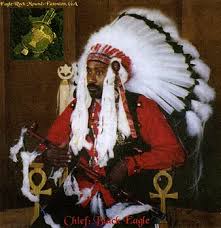
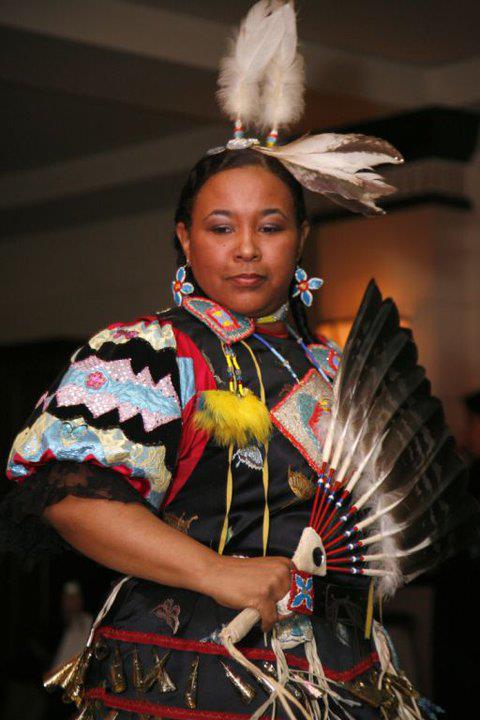
Suppressed History And Land Rights Of Native People
The Pre-Columbian era incorporates all period subdivisions in the history and prehistory of the Americas before the appearance of significant European influences on the American continents, spanning the time of the original settlement in the Upper Paleolithic period to European colonization during the Early Modern period.
While the phrase "pre-Columbian era" literally refers only to the time preceding Christopher Columbus's voyages of 1492, in practice the phrase is usually used to denote the entire history of indigenous Americas cultures until those cultures were exterminated, diminished, or extensively altered by Europeans, even if this happened decades or centuries after Columbus's first landing. For this reason the alternative terms of Precontact Americas, Pre-Colonial Americas or Prehistoric Americas are also in use. In areas of Latin America the term usually used is Pre-Hispanic.
Olmec Civilization
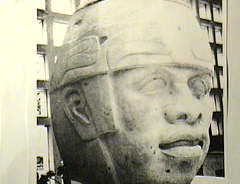
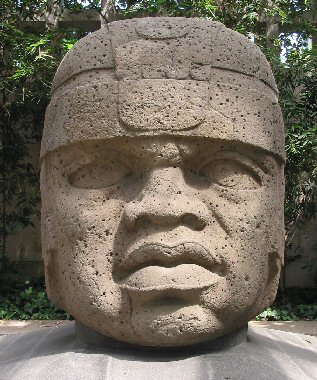
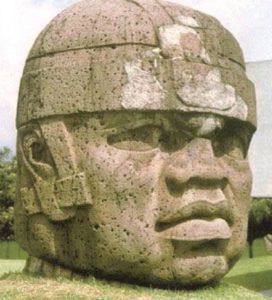
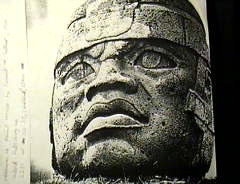
It is the oldest known civilization in the Americas and one of the five sites where civilization originated independently and indigenously in the ancient world, flourishing between the 30th and 18th centuries BC. It pre-dated the Mesoamerican Olmec civilization by nearly two millennia.
Afro-Olmecs Came From The Mende Region Of West Africa
Although archeologists have used the name "Olmec," to refer to the Black builders of ancient Mexico's first civilizations, recent discoveries have proven that these Afro-Olmecs were West Africans of the Mende language and cultural group. Inscriptions found on ancient monuments in parts of Mexico show that the script used by the ancient Olmecs was identical to that used by the ancient and modern Mende-speaking peoples of West Africa. Racially, the collosal stone heads are identical in features to West Africans and the language deciphered on Olmec monuments is identical to the Mende language of West Africa, (see Clyde A. Winters) on the internet.
The term "Olmec" was first used by archeologists since the giant stone heads with the features of West African Negritic people were found in a part of Mexico with an abundance of rubber trees. The Maya word for rubber was "olli, and so the name "Olmec," was used to label the Africoid Negritic people represented in the faces of the stone heads and found on hundreds of terracotta figurines throughout the region.
Yet, due to the scientific work done by deciphers and linguists, it has been found out that the ancient Blacks of Mexico know as Olmecs, called themselves the Xi People (She People).
Apart from the giant stone heads of basalt, hundreds of terracotta figurines and heads of people of Negritic African racial reatures have also been found over the past hundred years in Mexico and other parts of Meso-America as well as the ancient Black-owned lands of the Southern U.S. (Washitaw Proper,(Texas, Louisiana, Mississippi, Oklahoma, Arkansas), South America's Saint Agustin Culture in the nation of Colombia, Costa Rica, and other areas) the "Louisiana Purchase,"
lands, the south-eastern kingdom of the Black Jamassee, and other places including Haiti, see
the magazine Ancient American).
Various cultural clues and traces unique to Africa as well as the living descendants of prehistoric and ancient African migrants to the Americas continue to exist to this very day. The Washitaw Nation of Louisiana is one such group (see www.Hotep.org), the Garifuna or Black Caribs of the Caribbean and Central America is another, the descendants of the Jamasse who live in Georgia and the surrounding states is another group. There are also others such as the Black Californian of Queen Calafia fame (the Black Amazon Queen mentioned in the book Journey to Esplandian, by Ordonez de Montalvo during the mid 1500's).
Cultural artefacts which connect the ancient Blacks of the Americas with Africa are many. Some of these similarities can be seen in the stone and terracotta works of the ancient Blacks of the Americas. For example, the African hairline is clearly visible in some stone and terracotta works, including the use of cornrows, afro hair style, flat "mohawk" style similar to the type used in Africa, dreadlocks, braided hair and even plain kinky hair. The African hairline is clearly visible on a fine stone head from Veracruz Mexico, carved between 600 B.C. to 400 B.C., the Classic Period of Olmec civilization. That particular statuette is about twelve inches tall and the distance from the head to the chin is about 17 centemeters. Another head of about 12 inches, not only posesses Negroid features, but the hair design is authentically West African and is on display at the National Museum of Mexico. This terracotta Africoid head also wears the common disk type ear plugs common in parts of Africa even today among tribes such as the Dinka and Shilluk.
One of the most impressive pieces of evidence which show a direct link between the Black Olmec or Xi People of Mexico and West Africans is the presence of scarification marks on some Olmec terracotta sculpture. These scarification marks clearly indicate a West African Mandinka (Mende) presence in prehistoric and ancient Meso-America. Ritual scarification is still practiced in parts of Africa and among the Black peoples of the South Pacific, however the Olmec scarification marks are not of South Pacific or Melanesian Black origins, since the patterns used on ancient Olmec sculpture is still common in parts of Africa. This style of scarification tatooing is still used by the Nuba and other Sudanese African people. In fact, the face of a young girl with keloid scarification on here face is identical to the very same keloid tatoos on the face of an ancient Olmec terracotta head from ancient Mexico. Similar keloid tattoos also appear on the arms of some Sudanese and are identical to similar keloid scars on the arms of some clay figures from ancient Olmec terracotta figurines of Negroid peoples of ancient Mexico.
DESCENDANTS OF PRECOLUMBIAN BLACKS IN THE U.S., CARIBBEAN, CENTRAL AMERICA AND SOUTH AMERICA AND THE FIGHT FOR THE RETURN OF THEIR STOLEN OCCUPIED LANDS
IN THE MIDST OF THE REPARATIONS DEBATE THE ISSUE OF RETURNING THE LANDS OF THESE BLACKS WHO ANCESTORS WERE HERE IN THE U.S. AND AMERICAS BEFORE COLUMBUS HAS ALREADY BEEN DONE WITH ONE BLACK NATION OF THE LOUISIANA TERRITORIES

The experience of the Washitaw Nation (or Ouchita Nation) of the Southern United States is another piece of solid evidence for the fact of pre-Columbian African presence and settlement in the Americas and specifically in the United States. According to an article carried in the magazine, 'The Freedom Press Newsletter, (Spring, 1996), re-printed from Earthways, The Newsleter of the Sojourner Truth Farm School (August, 1995), the Washitaw were
(and still are) a nation of Africans who existed in the Southern U.S. and Mississippi Valley region long before the 16th century Europeans arrived and even before there were "Native Americans" on the lands the Washitaw once occupied and still occupy today.
According to the article, "the Washitaw Nation "governed three million acres of land in Louisiana,
Arkansas, Oklahoma, Texas and Mississippi. They were ship builders (similar to the Garifuna of the Caribbean, who are also of pre-Columbian West Afrucan Mandinka Muslim origins (according to Harold Lawrence in 'African Presence in Early America,edt. by Ivan Van Sertima).
What is even more facinating about this aspect of hidden history of Blacks in America before Columbus is that the Washitaw Nation was known and recognized as a separate, independant Black nation by the Spanish and French, who were in the Louisiana Territories and Texas areas. According to the present leader of the Washitaw Nation, "when Spain ceeded the Louisiana Territory to France, they excluded the land belonging to the Washitaw Nation. France did not include it in the "Louisiana Purchase," and according to the leader, "This land
is not part of the United States of America." That point was made in the newspaper, "The Capitol Spotlight, June 1992.
In fact, the courts agreed that the land was not part of the U.S. and that in fact the Washitaw (Ouchita) Nation was on the land long before European Colonization: therefore, in legal decisions made, some of the ancient territory was returned. This historical decision was made about 1991.
This is the type of information seldom seen in the majority press, yet, the importance of that event clearly points to the incredible service small papers and magazines such as Ancient American or the Capitol Spotlight and The Freedom Press Newsletter have been making, along iwth internet news and information sites such as this one. So, here we see an example in the continental United States where Africans who came before slavery, before Columbus and thousands of years before Christ (over six thousand years B.C., according to the Washitaw chroniclers), were engaged in boat building, seafaring, trade and commerce in ancient times and who still exist today as a distinct Black Nation who have evidence and proof of their ownership of millions of acres of lands in the Southern U.S. and the Mississippi Valley. The Washitaw Nation held an important convention in June 1992, in Monroe, Louisiana and have held others since. (see www.Hotep.org for the Washitaw's point of view on their history and culture).
Yet, the Washitaw is merely one nation of the descendants of pre-columbian Blacks from Africa and elsewhere and possibly from right here in the Americas as the very first people to exist here, long before the development of the Mongoloid, American Indians or the Mongoloid( 15,000 B.C.) or even the Caucasian races (30,000 B.C.). Pure Black Homosapiens began to migrate from Africa and populate the entire earth about 200,000 to 150,000 years ago, according to scientists, historians and anthropologists.
Among the other Black nations who existed in the Americas before Columbus and long before Christ were the Jamassee (Yamassee), who had a large kingdom in the South eastern U.S., Their descendants were among the first Blacks of pre-columbian American origins who fell victim to kidnapping for the purpose of enslavement. Blacks of South America, the Caribbean and Central America were also attacked and enslaved based on a Pontifax passed during the mid- 1400's by the Church hierachy giving the Europeans the go ahead to enslave all "Children of Ham" found in the newly discovered territories. The descendants of the Jamassee are the millions of Blacks who live in Alabama, Gerogia, South Carolina and northern Florida. They of course also have African slave ancestors, but these slaves are the relatives of the same Africans who sailed to America of their own free will, while Europe was in the Dark Ages, and long before Christ, for that matter.
In California, descendnats of the fierce "Black Californians" who were a Negroid people of African racial origins and the original owners of California and the South WEST (BEFORE THE SPANISH INVSION...OR THE CREATION OF THE MIXED RACE "HISPANIC" ETHNIC GROUP.
Many African-Americans in California are of Black Californian ancestry and their great grand parents were among the original Black Californians who were victims of Spanish Californio enslavement and Anglo American settler attacks. In fact, the Black Californian fought until the late 1800's to maintain control of their ancestral lands from the settlers. THAT'S A FACT.
There are aboriginal nations of Blacks in Panama such as the Afro-Darienite and the Choco people.
In fact, the Afro-Darienite are the remnants of the aboriginal Black nations of South and Central America who were once hunted down to be made slaves by the Spaniards (in fact Balboa or Peter Matyr chroniclers referred to these Blacks as "slaves of our lord," ) meaning, like Blacks in Africa, the South Pacific and elsewhere, they were eligible for enslavement, being descended from Ham, the so-called "father of the Black race."
In Columbia's Choco Region, on the Western side of that country, there are hundreds of thousands of Blacks, whose ancestors have been in Columbia for thousands of years. In fact, scientists and some historians have found out that Black slaves were being kidnapped and hunted down in Columbia and parts of South and Central America, as well as the Caribbean and U.S., by the Spaniards and others long before they began to look for slaves in Africa. (an old painting in Natonal Geographic clearly shows a black with bow and arrow and wearing a loin cloth, hunting along the coast of Columbia during the first voyage there by the Spaniards.
These Blacks today of the Choco Region of Columbia are among the most oppressed of Blacks in Latin America today (See the Final Call back issues on this topic)
Then there is the Garifuna or Kalifunami also called "Black Caribs" Being a member of the Black Carib Nation and having done historical research, the myth of the Black Caribs being escaped slaves has been debunked. It is true that the Black Caribs encouraged slaves from the West Indies Islands to join them and that the Black Caribs did ally with the Mongoloid Caribs of Dominica and other parts of the West Indies, but the fact remains, that the Black Caribs were originally Mende traders of gold and cloth, who established settlements throughout the Circum-Caribbean region, Mexico, Central America, South America and the Southern U.S.
They had been arriving in the Americas for thousands of years, even before they converted to Islam during the 900's A.D.. In fact, the Olmecs of ancient Mexico were Mende, they used the Mende script (found on monments at Monte Alban, Mexico, and they named places from southern Mexico to South America with Mandinka names. Such names sometimes sound identical to the names of places used in West Africa.
In retrospect, while the debate for reparations increses, it is important that African-Americans know that two great injustices were committed by the Europeans. The first was slavery, the second was the taking of Black lands and destroying Black history and culture so Blacks remain totally ignorant of their rights to more than one third of north America. NOW YOU KNOW WHY THE SLAVEMASTERS DID NOT WANT BLACK FOLK TO LEARN TO READ, AND WHY PLANTS ARE PLACED IN CHATROOMS AND ON FORUMS TO ATTEMPT TO DISCREDIT ANY USEFUL HISTORY AND INFORMATION OFFERED TO BLACK PEOPLE.
Still, TRUTH SUBMERGED SHALL RISE AGAIN.
Nubian-Kushite King and Queen (circa 1000 B.C.)
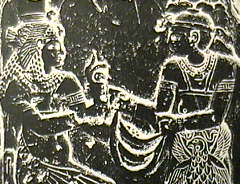
It is believed that there was a Nubian presence in Mexico and that the West African civilizations were related to that of the Nubians, despite the distance between the two centers of Black civilization in Africa. There is no doubt that in ancient times there were commercial ties between West Africa and Egypt. In fact, about 600 B.C., Nikau, a Pharaoh of Egypt sent ships to circumnavigate Africa and later on about 450 B.C., Phoenicians did the same, landing in West Africa in the nation now called Cameroon. There they witnessed what may have been the celebration of a Kwanza-like harvest festival, where "cymbals, horns," and other instruments as well as smoke and fire from buring fields could be seen from their ships. At that period in history, the West African cultures and civilizations, which were offshoots of much earlier southern Saharan cultures, were very old compared to civilizations such as Greece or Babylon. In fact, iron was being used by the ancient West Africans as early as 2600 years B.C. and was so common that there was no "bronze age" in West Africa, although bronze was used for ornaments and instruments or tools. A combination of Nubians and West Africans engaged in mutual trade and commerce along the coasts of West Africa could have planned many trips to and from the Americas and could have conducted a crossing about 1500 B.C. and afterwards. Massive sculptures of the heads of typical Negritic Africans were carved in the region of South Mexico where the Olmec civilization flourished. Some of these massive heads of basalt contain the cornrow hairstyle common among West African Blacks, as well as the kinky coiled hair common among at least 70 percent of all Negritic people, (the other proportion being the Dravidian Black race of India and the Black Australoids of Australia and South Asia). Afro-Olmec head
SUSU ECONOMICS
THE HISTORY OF PAN-AFRICAN TRADE, COMMERE, WEALTH AND MONEY
(A Preview of the Facinating History of the Development of Ancient Black Civilizations Worldwide)
One of the most important aspects of Black history worldwide is the development of Black civilization due to the early and persisten use and application of trade and commerce. Due to such early and well organized trading and commercial systems throughout the prehistoric Black world, Blacks were able to expand throughout the world and establish the world's first cultures and civilizations. Although it is said that Blacks migrated from the original homeland of mankind in Africa to settle all Asia, Europe, Australia and the Americas (see Scientific American; Sept. 2000, p. 80-87...this is a recent publication), long before the differentiation of the races from the original Negritic to Negriic, Caucasoid, Mongoloid, along with the various mixed races such as Polynesians, Native Americans, Japanese, Malays, Mediterranean whites, East Indians (the mixed Negroid/Caucasian type...not the pure Black pre Aryan Negritic Indians), Arabs, Latinos (Mestizos, Mullatoes, Zambos, Spaniards) and a number of other mixed races and regional types, the purpose of the earlies migrations of Blacks from Africa to the rest of the world was not merely following and hunting wild animals, as some theorists have claimed, but searching for commodities, like red ocre to paint the smooth, dark skin from insects and decoration. Another purpose for the early migrations of Africans to other parts of the world was to establish trading and commercial links to those of their own people, who had left previously. Hence, even if the earliest migrations were after wandering herds of animals, further migrations were in search of links with their kinsmen and women.
The migrations of Africans to all parts of the world within the past hundred thousand years or more occurred before an other races existed. Thus, Black culture and civilization was being established when no other "races" existed as we know them today. This is a facinating historical even, because having been homosapiens for over one hundred thousand years, it is very possible that Blacks could have gone through many periods of cultural development and civilization before the beginning of the Nile Valley civilization (since about 17,000 B.C.) or the Zingh Civilization of the South-Western Sahara (15,000 B.C.), or even Atlantis (10,000 B.C.), or the building of the Sphinx (7,000 B.C.).
In fact, there is evidence from ancient East Indian chronicles (some of these pictures are on AAWR (African American Web Ring) of the geat scientific advancement of the Black prehistoric inhabitants of the Indus Valley Civilization (6000 b.c. to 1700 b.c), who built flying machines, who had flushing toilets, cities on a gridlike pattern, and many of what we may call "modern" conviniences.
About 20,000 years ago, the present-day dried up and desertified Sahara had an aquatic civilization where the Africans who lived on the edges of the giant inland sea, built large ocean-going ships. Rock paiintings of these ships can still be seen in the Sahara (and some appeared on national geographic magazine about two years ago). (For more on the Aquatic Civilizations of the prehistoric Sahara, see, "African Presence In Early Asia," by Ivan Van Sertima and Runoko Rashidi, Transaction Publications, New Bruinswick, NJ).
The Africans who used these boats (which are still used today by tribes such as the Baduma of Mali, West Africa) made of papyrus straw. These same type of boats were used to travel to the Americas, the Indian Ocean, the South Pacific, India, East Asia and the Pacific, then to the Americas via the Pacific Ocean. In fact, the Fijians still consider Africa's East Coast to be their very ancient homeland and Africans in East Africa have oral as well as written histories of ancient journies towards Asia. In ancient times, trade between Africans in Africa and those in the Indian Ocean, East Asia and the Pacific Ocean, East Asia, the Americas, the Mediterranean, the Black Sea area and all the continents including Australia. In all these areas, evidence of prehistoric African Blacks exist. IT IS VERY IMPORTANT TO NOTE THAT SUCH EVIDENCE WAS AGAIN FOUND IN SOUTH AMERICA, WHERE ABOUT FIFTY SKULLS REPRESENTING NEGROID PEOPLE WERE FOUND IN BRAZIL (see Scientific American, September 2000). However, this is no news to some Blacks, particularly those descended from the ancient prehistoric Blacks of America, such as the Wasitaw of the Louisiana area, the descendants of the Black Californians, the Jamassee and others; the Black Caribs of the Caribbean and Central America, the Choco Region Blacks of Columbia, South America and many others.
This book examines the history of Black trade and commerce. It examines how money was made in ancient times and how this legacy continued well into the colonial era to this very day.
In a time when Blacks worldwide are suffering economically, this book clearly contributes to the knowledge and helps build the confidence needed to initiate a Black world economic renaissance and Black economic, social, numerical and cultural development among Black Americans and Blacks elsewhere. Source: Paul Barton/RaceHistory.com
The experience of the Washitaw Nation (or Ouchita Nation) of the Southern United States is another piece of solid evidence for the fact of pre-Columbian African presence and settlement in the Americas and specifically in the United States.
According to an article carried in the magazine, 'The Freedom Press Newsletter, (Spring, 1996), reprinted from Earthways, The Newsleter of the Sojourner Truth Farm School (August, 1995), the Washitaw were (and still are) a nation of Africans who existed in the Southern U.S. and Mississippi Valley region long before the 16th century Europeans arrived and even before there were "Native Americans" on the lands the Washitaw once occupied and still occupy today.
According to the article, "the Washitaw Nation "governed three million acres of land in Louisiana,Arkansas, Oklahoma, Texas and Mississippi. They were ship builders (similar to the Garifuna of the Caribbean, who are also of pre-Columbian West Afrucan Mandinka Muslim origins (according to Harold Lawrence in 'African Presence in Early America,edt. by Ivan Van Sertima).
What is even more facinating about this aspect of hidden history of Blacks in America before Columbus is that the Washitaw Nation was known and recognized as a separate, independant Black nation by the Spanish and French, who were in the Louisiana Territories and Texas areas.
According to the present leader of the Washitaw Nation, "when Spain ceeded the Louisiana Territory to France, they excluded the land belonging to the Washitaw Nation. France did not include it in the "Louisiana Purchase," and according to the leader, "This landis not part of the United States of America." That point was made in the newspaper, "The Capitol Spotlight, June 1992.
This is the type of information seldom seen in the majority press, yet, the importance of that event clearly points to the incredible service small papers and magazines such as Ancient American or the Capitol Spotlight and The Freedom Press Newsletter have been making, along iwth internet news and information sites such as this one.
So, here we see an example in the continental United States where Africans who came before slavery, before Columbus and thousands of years before Christ (over six thousand years B.C., according to the Washitaw chroniclers), were engaged in boat building, seafaring, trade and commerce in ancient times and who still exist today as a distinct Black Nation who have evidence and proof of their ownership of millions of acres of lands in the Southern U.S. and the Mississippi Valley.
The Washitaw Nation held an important convention in June 1992, in Monroe, Louisiana and have held others since. (see www.Hotep.org for the Washitaw's point of view on their history and culture).
Yet, the Washitaw is merely one nation of the descendants of pre-columbian Blacks from Africa and elsewhere and possibly from right here in the Americas as the very first people to exist here, long before the development of the Mongoloid, American Indians or the Mongoloid( 15,000 B.C.) or even the Caucasian races (30,000 B.C.). Pure Black Homosapiens began to migrate from Africa and populate the entire earth about 200,000 to 150,000 years ago, according to scientists, historians and anthropologists.
Among the other Black nations who existed in the Americas before Columbus and long before Christ were the Jamassee (Yamassee), who had a large kingdom in the South eastern U.S., Their descendants were among the first Blacks of pre-columbian American origins who fell victim to kidnapping for the purpose of enslavement.
Blacks of South America, the Caribbean and Central America were also attacked and enslaved based on a Pontifax passed during the mid- 1400's by the Church hierachy giving the Europeans the go ahead to enslave all "Children of Ham" found in the newly discovered territories.
The descendants of the Jamassee are the millions of Blacks who live in Alabama, Gerogia, South Carolina and northern Florida. They of course also have African slave ancestors, but these slaves are the relatives of the same Africans who sailed to America of their own free will, while Europe was in the Dark Ages, and long before Christ, for that matter.
In California, descendnats of the fierce "Black Californians" who were a Negroid people of African racial origins and the original owners of California and the South WEST (BEFORE THE SPANISH INVSION...OR THE CREATION OF THE MIXED RACE "HISPANIC" ETHNIC GROUP.
Many African-Americans in California are of Black Californian ancestry and their great grand parents were among the original Black Californians who were victims of Spanish Californio enslavement and Anglo American settler attacks. In fact, the Black Californian fought until the late 1800's to maintain control of their ancestral lands from the settlers. THAT'S A FACT.
There are aboriginal nations of Blacks in Panama such as the Afro-Darienite and the Choco people.
In fact, the Afro-Darienite are the remnants of the aboriginal Black nations of South and Central America who were once hunted down to be made slaves by the Spaniards (in fact Balboa or Peter Matyr chroniclers referred to these Blacks as "slaves of our lord," ) meaning, like Blacks in Africa, the South Pacific and elsewhere, they were eligible for enslavement, being descended from Ham, the so-called "father of the Black race."
In Columbia's Choco Region, on the Western side of that country, there are hundreds of thousands of Blacks, whose ancestors have been in Columbia for thousands of years. In fact, scientists and some historians have found out that Black slaves were being kidnapped and hunted down in Columbia and parts of South and Central America, as well as the Caribbean and U.S., by the Spaniards and others long before they began to look for slaves in Africa.
(an old painting in Natonal Geographic clearly shows a black with bow and arrow and wearing a loin cloth, hunting along the coast of Columbia during the first voyage there by the Spaniards.
These Blacks today of the Choco Region of Columbia are among the most oppressed of Blacks in Latin America today (See the Final Call back issues on this topic)
Then there is the Garifuna or Kalifunami also called "Black Caribs" Being a member of the Black Carib Nation and having done historical research, the myth of the Black Caribs being escaped slaves has been debunked. It is true that the Black Caribs encouraged slaves from the West Indies Islands to join them and that the Black Caribs did ally with the Mongoloid Caribs of Dominica and other parts of the West Indies, but the fact remains, that the Black Caribs were originally Mende traders of gold and cloth, who established settlements throughout the Circum-Caribbean region, Mexico, Central America, South America and the Southern U.S.
They had been arriving in the Americas for thousands of years, even before they converted to Islam during the 900's A.D.. In fact, the Olmecs of ancient Mexico were Mende, they used the Mende script (found on monments at Monte Alban, Mexico, and they named places from southern Mexico to South America with Mandinka names. Such names sometimes sound identical to the names of places used in West Africa.
The Amurru Washitaw Dedugdahmoundyah Muurs (Moors) were originally a group of priest from Egypt, also known as the Dogon/Olmecs/Mayans. The term Washitaw is a corruption of Ursahtaw, the father and mothers of the mystics. In Egyptian, Ursahtaw is Urrashet, the winged sun disk, which symbolizes the highest knowledge, the pineal gland being open.
Amurru is actually a corruption of Amaru, which is the root Ameri-ca. America is actually a corruption of Amen-Ra-Ka. Its strange how everything comes from Egypt. Well Egypt was once the capitol of the world. In fact, the Pharaoh gave the ancient Moabites (Moors) permission to settle Morrocco, which is now North Africa. The Moabites migrated to modern-day America, and called her Almorrocco, which is another root for the word, America.
The last of the U.S. consular courts of Morocco was abolished in 1956. The 1787 Morocco Treaty of Peace and Friendship was a means to try to stop all of the fighting over land, so the Moors brung the Europeans to the table to form a peaceful two system goverment; one for the Moors and one for the Europeans. Evidence of this two system goverment can be found on the back of a one dollar bill. Notice the two seals. You see one of a pyramid with an eye above it, which was the Moorish seal, and the other seal is that of a eagle holding 13 arrows, which is the European seal.
Another example of this two system goverment is the Consular Court, which was the Moorish court system. The last one was abolished in 1956 according to the above definition, and this Consular Court was granted its authority by treaty, that is, the 1787 Morocco Treaty of Peace and Friendship. The Europeans had and still do have their court systems, but its just their system now. Empress Verdiacee Tiari washitaw -Turner Goston El Bey wrote in her book, "The Return of the Ancient Ones," that "85% of the blacks over here in America were already here before the slave trade.
In Oklahoma in the 1800’s, a stele of Pharaoh Akhenaten (Amenhotep IV, aka, Moses of the Bible) was found (See “Ice: the Ultimate Disaster,” by Richard Noone). In the book, “America BC,” there is an alabaster egg of a cartouche of King Tut found in Idaho: http://bit.ly/9ZZz0F . Africans and Native Americans, by Dr. Jack Forbes, states, “The slave trade started in America and the slaves were taken mostly to Spain and Europe.
When the Spanish came to America they found the Indios (Indians), the black people who are with God.” All of the evidence proves that blacks are the oldest natives in America, hands down. Why is this information suppressed? Well Europeans want you all to believe that blacks only come from Africa to keep the land they have taken and not feel so guilty about it. If you can distort the history of the blood shed for the land, you can appear more humane. That's exactly what they did. They wrote a his-story book after they were firmly established to tell his-story more humanely. The American- His-story book has been a great success because it has most of the world blind as to what really happen.
The Amurru Washitaw Dedugdahmoundyah Muurs (Moors) lay claim to the following land by and through bloodline: de bourbon Estate, also known as The Emperial International Estate of the Bourbon Hapsburg Empire which includes Western Europe: The Netherlands, Belgium, Luxembourg, Switerland, Germany, Italy, Sicily, Naples, Sardina, Spain, and Portugal.
As well as most of North America and Caribbean in addition to Central and South America; and all of North America west of the Emperial Demarcation Line (1713) or British Royal Proclamation Line (1763). This is the breakdown of the Royal Emperial Bloodlines for the Washitaw Moors: The young heir to the French Throne, King Louis XVII, married the young heiress to the Washitaw-Tunica Throne, Ayimarieeyah. Their Emperial/Imperial marriage would become official in 1795, pursuant to the conveyance of Spanish Land Grants bestowed upon the young heir, King Louis XVII, and his wife and heiress, Ayimarieeyah.
These two would also receive the Imperial Spanish Land Grant of 1763. As a recipient of both the 1762 and 1795 Spanish Land Grants, King Louis XVII,became known as Marrquis de Maison Rouge: owner of Louisiana and Florida. Upon the death of Ayimarieeyah and King Louis XVII, the Titles of Louisiana Dauphin and Regent Marquis de Masion Rouge were conveyed to the next-in-line to the Imperial French Crown, Louis Francis Joseph de Bourbon, Prince de Conti (1734-1814) the son of Louis Francis de Bourbon, Prince de Conti (1717- 1776).
The Daughter of Ayimarieeyah and King Louis XVII married Louis Francis Joseph de Bourbon, Prince de Conti. As the second Marquis de Masion Rouge, Louis Francis Joseph de Bourbon, became the recipient of both the Imperial Spanish Land Grants of 1762 and the Spanish Land Grant of Monroe, Louisiana. With the death of Joseph de Bourbon, his eldest son, Henry Joseph Turner inherited the Maison Rouge Estate. Henry Joseph Turner became the recipient of 1762 and 1795 Imperial Spanish Land Grants; making, him the third Marquis de Masion Rouge.
Henry Joseph Turner married Sarah Tunica (Turner); and from this union came their eldest son: Joseph Henry Turner, the fourth Marquis de Masion Rouge Prophet Noble Drew Ali was the fifth Marquis de Masion Rouge by and through his mother, Eliza, a daughter of Sarah Tunica and Henry Joseph Turner. Corrella Turner (Tunica) is the sister of Noble Drew Ali. Corrella's son, John Goston, is married to a direct descendent of Ayimarieeyah and King Louis XVII: Verdiacee Tiara Washington (Washitaw). Empress Verdiacee is the sovereign. Her union with John Goston makes him the sixth Marquis de Masion Rouge.
The Royal Imperial/Emperial bloodlines have never be broken; therfore, ownership of most of North America and other lands belongs to Verdiacee Tiara Washington and her husband, the sixth Marquis de Masion Rouge, John Goston. They are the rightful owners of most of America and lands elsewhere. John Jay, the 1st chief justice of the US Supreme Court once said, "Those who own the country ought to govern it."
I've proven that theWashitaw Muurs (Moors) own most of North America and lands elsewhere through the propery rights of their current Queen and King, Verdiacee Tiara Washington and her husband, the sixth Marquis de Masion Rouge, John Goston; therefore, they should govern it according to Supreme Court Justice, John Jay. Given the Secret Treaty of San Il-defonso of 1800, the de Bourbon, Charles IV, king of Spain, seceded to the French Emperior Napoleon Bonaparte, the seaport city of New Orleans only, not the whole of Louisiana; so what Napoleon ceded to US President Thomas Jefferson was the Port of New Orleans, not the whole of Louisiana as claimed by the US in the so-called Louisiana Purchase Treaty of 1803.
This fact has been secured in the Secret Treaty of San Il-defonso of October 1, 1800. (See the Secret Treaty to see the unlawfulness of the Louisiana Purchase: http://www.napoleon-series.org/research/government/diplomatic/c_ildefonso.html ) US President, Thomas Jefferson, sent Robert Livingston to purchase the Louisiana Purchase from Napoleon Bonaparte.
Napoleon only had the power to sell the harbor city of New Orleans to the United States. According to The Secret Treaty, Napoleon violated International law by selling the city without consent from spain; making, the deal null and void. The Washitaw received no money from the Lousisiana Purchase and the purchase exceeded its boundaries by covering over 15 states and parts of Canada which were never part of the deal. The United States took land without giving the Washitaw due process and eual protection of the law, which should have come in the form of a hearing and compensation for their land. This never transpired; therefore, the land was unlawfully taken from the Washitaw by the government.
As a result of this evidence and the fact that according to Article VI, of the United States Constitution, “Treaties are the supreme law of the land,” and the 14th and 5th Amendments of the US. Constitution, “No person shall be deprived of life, liberty, or property without due process and eual protection of the laws;” the United Stated is in direct violation of Constitutional and International law by occupying Florida and 15 current U.S. states and two Canadian provinces, better know as the Louisiana Purchase (This link will give you the names of the states involoved in the unlawful Louisiana Purchase: http://en.wikipedia.org/wiki/Louisiana_Purchase). According to due process of the law and equal protection of the law, if the government can’t give the washitaw their land back, the government is bound by the law to give the Washitaw Moors just compensation for their land in the form of payment.
There is documentation in The National Archives in Washington, D.C. and elsewhere that confirm the Washitaw Moor presence right here in North American lands, thousands of years before the arrival of the first European(s), and their advanced civilization identified them as The Ancient Ones, geophysical mound builders (Uaxashaktun de Dugdahmoundyah), and their prior claim to the land was never disputed, evil deeds stole away their possession of and their control of their Ancient lands, partially identified in the record as (1) 1848 U.S. Supreme Court ruling in the case of the “U.S. Government vs. The Heirs of Henry Turner” (Tunica), in which the High Court found that "The Neutral Strip” (2,961,983.5 acres of land) was definitely not a part of the territory ceded to the United States" (Louisiana Dept. of Transportation, 1940), (2) the 1992 return of 68,883 acres of land by the State of Louisiana (Land Grant #923/1991), designated "Washitaw Proper;" and (3) "Washitaw Terra" including The Floridas.
I have attached two United states Supreme Court cases in which the Washitaw won these cases: http://supreme.justia.com/us/44/773/case.html ; and http://supreme.justia.com/us/52/663/ The United Nations High Commission for Human Rights recognizes the self-declarations of indigenous peoples, and acknowledges Uaxashaktun (Empire Washitaw) as "The oldest indigenous people on Earth," and assigned UN Grant Application #215 (1993) to the Washitaw Moors.
The United States has recognized Amurru Washitaw de Dugdahmoundyah as an indigenous people of North America and had under consideration in the 105th Congress (H.R. #260), The Guadalupe-Hidalgo Treaty Land Claims Act of January, 1997.
A series of Congressional Bills/Acts and US Supreme Court cases reaffirm national sovereignty for the heirs of Henry Turner de Bourbon (1848, Case #191: United States v. Henry Turner’s Heirs); and the claim has been recorded before the World Court at The Hague (1996), that since the Treaties of Utrecht (1713) in which the Spanish de Bourbon had established themselves as the Protectorate of lands known as the Floridas, on behalf of Amurru Washitaw de Dugdahmoundyah.
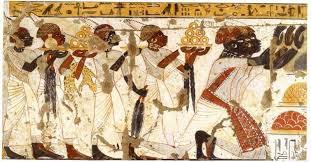
According to The Declaration of Indigenous Rights, indigenous people are those who embody historical continuity with societies which existed prior to the conquest and settlement of their territories by Europeans. As well as people bought involuntary to the new World. (See http://bit.ly/cJpHi4 ) According to the above United Nations treaty, all black people are indigenous. This means that Blacks are natural persons. All natural persons are human beings and sovereigns of the land, because they rightfully own the land. This is coming from the Black's Law Dictionary. Just look up natural persons.
All blacks are beyond first class citizens and don't even know it, because we have accepted His-story and slave labels like, negro, black, and colored. What makes the above treaty so powerful is that according to Article VI of the United States Constitution, "Treaties are the Supreme law of the land."
The United States of America is apart of the United Nations, so the Government is bound by it. Sovereignty resides in your nationality. Your Nationality ties you back to the land. What is your nationality? My nationality is Washitaw de dugdahmoundyah Mu’ur (Moor), which is an off branch of the Kushite Empire, the Songhai Empire, and the Ottoman Empire.
The washitaw tribal Moors are listed at the United Nations under the Indigenous People Organization Number 21593. This became effective in 1993. The seat number for the Washitaw at the United Nations is 215.
According to International Law, the Washitaw has established itself as a Sovereign Independent Nation (United Nations, NIS-21/593) apart from corporate union of 1781 and the corporate United States of 1787. The land claim of the Washitaw haas been affirmed by the Spanish and French, as well as British, pursuant to Spanish Land Grants of 1762 and 1795.
According to Federal Law, the land of the Washitaw has been defined as "Indian Country," and the people regarded as Indians. Both the people and their land have been placed under the authority of the United States government via the Bureau of Indian Affairs within the Department of Interior, which is governed by both Executive and Congressional Plenary powers. As a result, the United states has assumed the "Trust responsibility" for the Washitaw Nation of Muurs (Moors) via Spanish Land Grant of Henry Turner.
The Washitaw Muurs enjoy divesity of citizenship jurisdiction, because they are a nation within a nation. All Washitaw Muurs enjoy dual citizenship status.
They are citizens of the United States of America, not the United States, and citizens of the Washitaw Nation. I wrote this blog to educated the public about the Washitaw Moors and to show and prove who owns America, lawfully. I hope and pray that this blog will help you discover who you are by empowering you with the truth. God bless all and thank you for reading this blog. Make sure you follow me on twitter at www.Twitter.com/TooCooL747. Thank you and enjoy this great blog.
Lower Paleolithic
Lower Paleolithic cultures predominantly used large pear shaped or oval stone tools, often referred to as Acheulean hand axes. Unmodified flakes which were chipped from the stone core were also used for cutting. One of the oldest examples was discovered in sediment laid down by the Nile close to Abu Simbel at around 700,000 years ago. This date may not be certain, but there is firm evidence of Acheulean technology in the Western Desert at 300,000 BC. One of the most interesting settlements from the period, Arkin 8, was discovered close to Wadi Halfa near the modern border with Sudan.
Middle Paleolithic
During the Middle Paleolithic Period (around 250,000 to 50,000 ago) Acheulean hand axes became rare, replaced by small flake-tools made using the Levallois Method (striking flakes of stone from a prepared core. Middle Paleolithic tools have been found in the Nile Valley and Nubia, but the best preserved examples come from the Western Desert, in particular Bir Sahara and Bir Tarfawi. Around 90,000 years ago the climate began to change and the Sahara became the arid desert we recognise today. People migrated to the Nile Valley and the oases (such as Kharga).
Middle Paleolithic flints from the Valley of the Kings copyright Didier Descouens Cultures in this period are referred to as Mousterian, Aterian and Khormusian with reference to the type of tools they preferred. Some scholars have proposed that these cultures followed each other sequentially. However, radiocarbon dating suggests that they overlapped in time. It is also proposed that they were in fact the same group of people, just using different tools in different situations.
Tools, such as the stone tipped throwing spear, allowed the people to develop their hunting skills and take on much larger prey. As a result, the people flourished and left behind large numbers of tools to attest to their abundance. An interesting find from this period (dated to around 55,000 years ago) is the Paleolithic burial of an anatomically modern child at Taramsa, close to Dendera. The environment became more arid around 37,000. The great oasis at Kharga dried up and the flora and fauna which had sustained the Middle Paleolithic cultures vanished.
The Mousterian and Aterian cultures had to leave or die. It is likely that those who survived made their way to the Nile valley where they met the Khormusian peoples (and probably others so far not distinguished). Arguably the most important site from this period is Nazlet Khater, the site of the earliest known undergro und mining complex in the world (dated to around 35,000 to 29,500 BC).
Several shafts and underground chambers were excavated to reach the chert cobbles from which lithic blades (long slender shards struck off from a prepared core) could be made. Nearby, archaeologists found the second earliest human burial in Egypt, and the earliest known funerary gift (a bifacial axe).
Upper Paleolithic
Upper Paleolithic or Late Paleolithic (around 21,000 to 12,000BC) cultures are characterised by the long thin stone blades they commonly employed. The blades are so thin that it is suggested they were used to form harpoons and arrows. These tools represent a refinement of the Khormusian technology which is referred to as Halfan. Between 17,000 and 13,000 Egypt benefitted from a wetter and more hospitable climate and the Halfan people flourished alongside three other cultural groups; the Kubbaniyan, the Idfuan and the Qadan.
Archaeological evidence suggests more regional variation and local innovation that in earlier periods, and a greater diversity of subsistence strategies and hunting and gathering practices. The development of the mortar and pestle allowed grains and tubers (some of which were only edible once ground) to form a larger part of their diet. The Kubbiyaniyan peoples also employed communal storage facilities implying greater social complexity and an understanding of how (and for how long) they could store produce. With the end of the last Ice Age around 13,000 to 12,000 ago, increased rainfall cause the White Nile to flow again.
This wetter period saw a series of very high Nile floods referred to as the "Wild Nile". Qadan burials from this period display the earliest evidence of ancient conflict. Large numbers of the people, who were often buried in communal graves, show signs of violence. Some still have stone shards embedded in their bones. Another important site from the period is the cemetery at Wadi Tushka, north of Abu Simbel. Here a number of burials were marked with the skulls of cattle prefacing the importance of domestic cattle in later C Group and Kerma cultures.
Epipaleolithic
Two main cultural groups have been found which date to the Epipaleolithic (or final Paleolithic) Period; the Qarunian culture in the Faiyum, and the Elkabian culture in Upper Egypt. The Qarunian people (also designated as Faiyum B) hunted gazelle, hippo, waterfowl and hartebeest and fished extensively. Evidence of their campsites along the banks of the warshland dater to between 6240 and 5480 BC.
In retrospect, while the debate for reparations increases, it is important that African-Americans know that two great injustices were committed by the Europeans. The first was slavery, the second was the taking of Black lands and destroying Black history and culture so Blacks remain totally ignorant of their rights to more than one third of north America.
NOW YOU KNOW WHY THE SLAVEMASTERS DID NOT WANT BLACK FOLK TO LEARN TO READ, AND WHY PLANTS ARE PLACED IN CHATROOMS AND ON FORUMS TO ATTEMPT TO DISCREDIT ANY USEFUL HISTORY AND INFORMATION OFFERED TO BLACK PEOPLE.
© Copyright BREAKING CHAINS MINISTRY